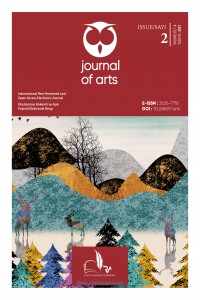The analysis of max ernest's some paintings examples: “The Eye of Silence”, “Europe After Rain II”, “Antipope”
Abstract
In Myths; Thev isible world is supported by an invisible world. Myths are based on there quirements of the subconsciousandv it alsphere, while it points to the depth of the imagination of a person who wants a certain worship and attachment. In this case, it shows that it is based on which is lived to get her mythological stories geography and depictions of gods with various cultural differences. Since human beings have fully developed their awareness, they have be gun tounder stand the environmentand interpret the nature in different meanings. Mythological stories dealt with as a subject in art and has found it splace in each period. Mythology, Jung and Freud, such as psychoanalysts are taking the lead in the effective foot steps. It is seen that many artists, especially Dali, dealt with this issue in the Surrealism movement. Max Ernst is one of them ostprominent of these artists. Max Ernst with “The Eye of Silence”, “Europe After Rain II”, “Antipope”; The imaginary land scapes are among the best images of the jarring beauty embodied in the crystal in the imagination of surrealists. These are objectified not from or dinary people, but from the eyes of a creature that exists in nature. The subtext of the works are very rich and encrypted like a puzzle. Them eaning of one eye is variable. On the onehand, according to the physiological position of the eye points to a different side than humanity, on the other hand in mythology, one-eyed giants in the body, brings to mind super human forces. In this study, the iconological analysis of Ernst’s “Eye of Silence, Europe After Rain II, Antipope” will be analyzed in the context of myth, mythology and art
Keywords
References
- CÖMERT, B. (1999). Mitoloji ve İkonografi. Ankara: Ayraç Yayınevi. ISBN: 978944492331
- ERGÜVEN, M. (2003). Kurgu ve Gerçek. İstanbul: Gendaş Kültür. ISBN: 9789753084987
- EVANS, A. (1974). Olivier Messiaen in the Surrealist Context:. United Kingdom: International Association of Music Libraries.
- FORDHAM, F. (2015). Jung Psikolojisinin Ana Hatları. Çevirenler: A.Yalçıner. İstanbul: Say Yayınları. ISBN: 9754680706 KAVKY, S. (2010). Max Ernst in Arizona: Myth, mimesis, and the hysterical landscape. The University of Chicago Press, 221-222
- PASERRON, R. (2000). Sürrealizm Sanat Ansiklopedisi. Çevirenler: S. Tansuğ. İstanbul: Remzi Kitabevi. ISBN: 975-140181-X
- VESELEY, D. (2018, 12 11). Eskop Sanat Tarihi dergisi.
- http://e-skop.com/skopdergi/surrealizm-mit-ve-modernite/1937 [Erişim Tarihi: 01.12.2018].
- https://www.kemperartmuseum.wustl.edu/collection/explore/artwork/541 [Erişim Tarihi: 04.04.2019].
- https://www.arthipo.com/tr-tr/yagmurdan-sonra-avrupa.html [Erişim Tarihi: 21.04.2019].
- https://www.guggenheim.org/artwork/1188, [Erişim Tarihi:25.04.2019].
Max Ernst’in resimlerinden çözümleme örnekleri: “Sessizliğin Gözü”, “Yağmurdan Sonra Avrupa II”, “Antipope”
Abstract
Mitlerde; Görünen dünya görünmeyen bir öte dünya ile desteklenmiştir. Mitler, bilinçaltı ve yaşamsal alanın gerekleri üzerinden kurgulanırken, daha çok belli bir tapınma ve bağlanma isteği duyan insanın hayal gücünün derinliğine işaret etmektedir. Bu durumda yaşanılan coğrafyada çeşitli kültür farklılıkları ile birlikte mitolojik hikâyeleri ve tanrıların varlığını betimleme üzerine kurgulandığını göstermektedir. Sanatta mitolojik hikâyeler konu olarak ele alınmış veher dönemde kendine yer bulmuştur. Mitoloji, Jung ve Freud gibi Psikanalistlerin ön ayak olduğu akımlarda da etkin biçimde yer alırken; Sürrealizm akımında başta Dali olmak üzere birçok sanatçının da bu konuyu ele aldığını görülür. Bu sanatçıların en önde gelenlerden biri de Max Ernst’tir. Ernst, “Sessizliğin Gözü”, “Yağmurdan Sonra Avrupa II”, “Antipope” adlı çalışmaları; hayali manzaraları, sürrealistlerin tasavvurunda kristalde cisimleşen sarsıcı güzelliğin en iyi görüntüleri arasındadır. Bunlar sıradan insanın değil, doğada var olan bir canlının gözünden nesnelleşmektedir. Yapıtların alt metni çok zengin ve bir bulmaca gibi şifrelidir. Tek gözün manası değişkendir. Bir yandan gözün fizyolojik konumuna göre insanlıktan farklı bir tarafa işaret ederken, öte taraftan mitolojide tek gözlü devlerde vücut bulan, insan ötesi güçleri akla getirir. Bu çalışmada Ernst’in “Sessizliğin Gözü Adlı, Yağmurdan Sonra Avrupa II, Antipope” yapıtları ikonolojik analizi mit, mitoloji ve sanat bağlamında ele alınıp çözümlenecektir
Keywords
References
- CÖMERT, B. (1999). Mitoloji ve İkonografi. Ankara: Ayraç Yayınevi. ISBN: 978944492331
- ERGÜVEN, M. (2003). Kurgu ve Gerçek. İstanbul: Gendaş Kültür. ISBN: 9789753084987
- EVANS, A. (1974). Olivier Messiaen in the Surrealist Context:. United Kingdom: International Association of Music Libraries.
- FORDHAM, F. (2015). Jung Psikolojisinin Ana Hatları. Çevirenler: A.Yalçıner. İstanbul: Say Yayınları. ISBN: 9754680706 KAVKY, S. (2010). Max Ernst in Arizona: Myth, mimesis, and the hysterical landscape. The University of Chicago Press, 221-222
- PASERRON, R. (2000). Sürrealizm Sanat Ansiklopedisi. Çevirenler: S. Tansuğ. İstanbul: Remzi Kitabevi. ISBN: 975-140181-X
- VESELEY, D. (2018, 12 11). Eskop Sanat Tarihi dergisi.
- http://e-skop.com/skopdergi/surrealizm-mit-ve-modernite/1937 [Erişim Tarihi: 01.12.2018].
- https://www.kemperartmuseum.wustl.edu/collection/explore/artwork/541 [Erişim Tarihi: 04.04.2019].
- https://www.arthipo.com/tr-tr/yagmurdan-sonra-avrupa.html [Erişim Tarihi: 21.04.2019].
- https://www.guggenheim.org/artwork/1188, [Erişim Tarihi:25.04.2019].
Details
| Primary Language | Turkish |
|---|---|
| Journal Section | Research Article |
| Authors | |
| Publication Date | May 20, 2021 |
| Published in Issue | Year 2021 Volume: 4 Issue: 2 |


